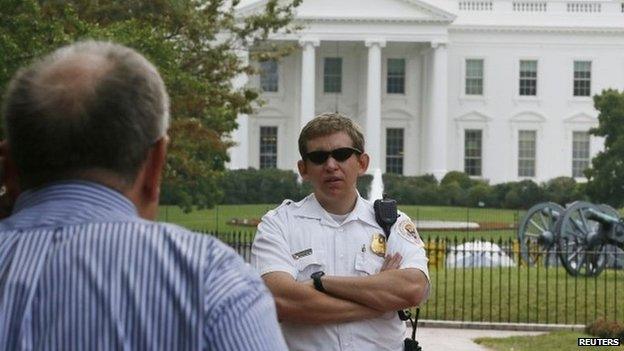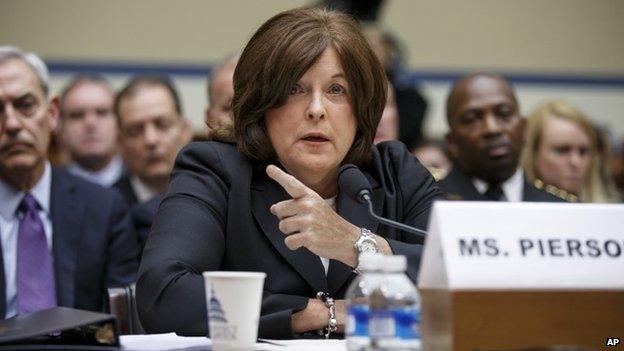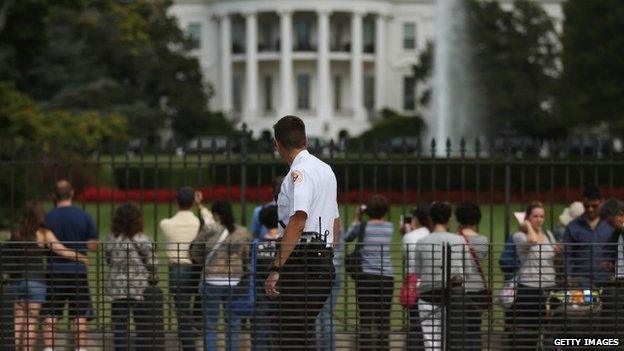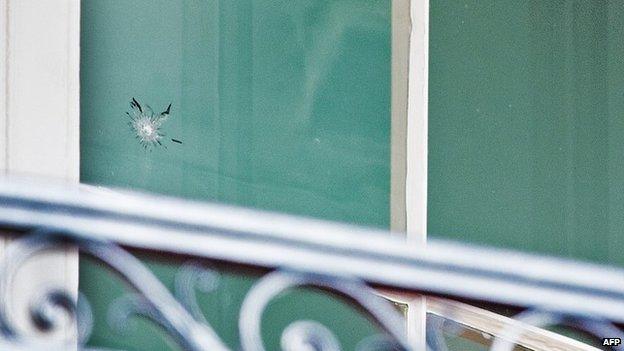Why is Omar Gonzalez alive and Mike Brown dead?
- Published
- comments

The Secret Service has been the focus of several scandals in the past year
How about this as an essay question for the future.
Compare and contrast the treatment of 18-year-old Michael Brown, in Ferguson, Missouri, and 42-year-old Omar Gonzalez at the White House, and what does it tell us about the maintenance of law and order in the US?
I am not going to write a windy treatise, full of careful annotations and sources and references listed at the end.
Instead I am just going to give you what I would have written as the concluding sentence - one was shot dead who should not have been while the other was not shot but probably should have been.
The case of Omar Gonzalez becomes more and more fascinating. He is a troubled Iraq War veteran who two weeks ago scaled the fence outside the White House, ran across the lawn, round the fountain, across the North Portico entrance where he was finally confronted by a Secret Service agent.
Mr Gonzalez ignored the challenge and carried on inside - the doors were not locked. Initially we were told that he barely got through the entrance.

Julia Pierson resigned as director of the protective agency after her appearance at a Congressional panel
But now we know that he managed to cross the marbled entrance hall, turning left past the staircase that leads to the Obama family's private quarters, and then into the East Room. It was there that he was eventually overpowered.
In the immediate aftermath, the former head of the Secret Service, Julia Pierson, praised the officers on duty that night at the White House for their extraordinary restraint.
"Restraint?" some commentators and lawmakers have exclaimed in disbelief.
In the era of the suicide bomber is restraint really what you want when an intruder armed with a knife has penetrated into the inner sanctum of the leader of the free world?
And you can see their point - if something awful had happened it's hard to believe those same officers would have been commended for keeping their guns holstered.

Residents of Ferguson, Missouri, continue to call for the officer who killed Michael Brown to be charged
On Wednesday, Ms Pierson resigned, following story after story about other Secret Service lapses, including an armed man in the same lift as Mr Obama.
At a hearing on Capitol Hill this week at least one congressman seemed to suggest the Secret Service should have shot Mr Gonzalez dead.
"If a would-be intruder cannot be stopped by a dog or intercepted by a person, perhaps more lethal force is necessary," Republican Jason Chaffetz told Secret Service director Julia Pierson.
"And I want those Secret Service agents and officers to know at least this member of Congress has their back."
So did they follow the correct operating procedure, or did they bottle it? Did they follow the rules of engagement, or did something go wrong?
"It's clear," Ms Pierson admitted, "that our security plan was not properly executed".
It is hard not to contrast the "restraint" shown to Mr Gonzalez with what happened to Michael Brown in Ferguson in August.

The black teenager was shot by a police officer six times after a suspected robbery at a nearby convenience store, even though no evidence has been offered that he posed a danger to the public or to the policeman who opened fire.
In all discussions like this, one rather ugly word is used - proportionality.
What is proportional use of force? Inevitably the answer to that depends on who you are, and what your vantage point is.
Outside the White House an extra low fence has gone up with a poster on it proclaiming "police line, do not cross". In the grounds there seems to be a lot more heavily armed Secret Service officers in the grounds. Is that proportionate?
Well here's the thing. If you've ever encountered a US presidential motorcade - or tried to get into the White House via conventional means - you would be a strange person who concluded what's needed was more security.

In 2011, a man fired at the White House but the bullet damage was not found for several days
The security is immense, extensive, oppressive, intimidating - and probably quite right too, given the threat levels.
Residents of Washington must put up with regular indignities at the hands of the often surly Secret Service agents and police who seemingly at a whim will shut down a street, block an intersection or demand to search one's bag as the price of access to a block one walks every day.
But they were unable to lock the White House door and set the alarm.
So would an extra 50, 100, 500 agents make a difference? You can have as many rings of steel as you like around the White House, but if the officers charged with protecting the president aren't being vigilant, then he won't be any safer.
Not the happiest hour for the US Secret Service.